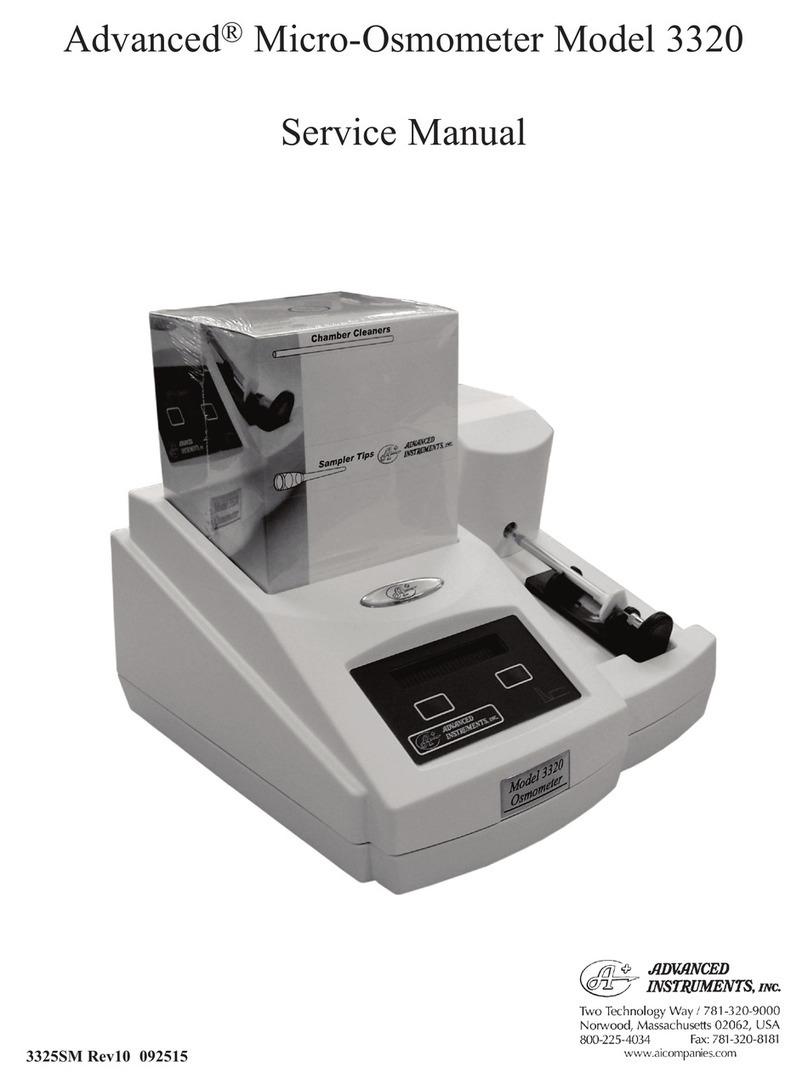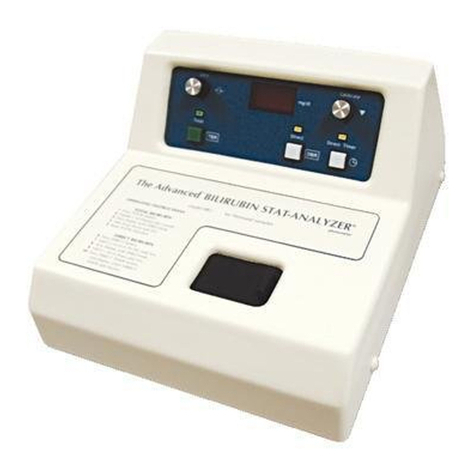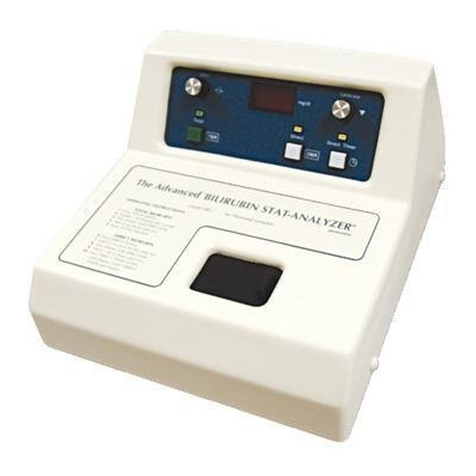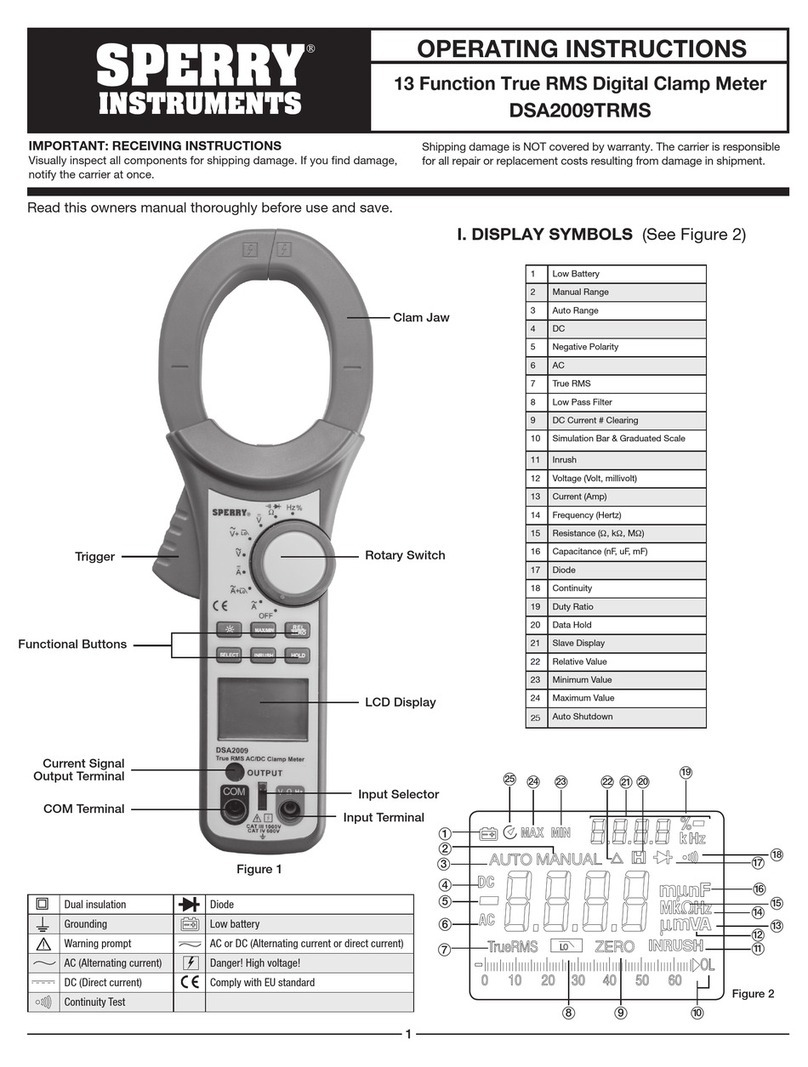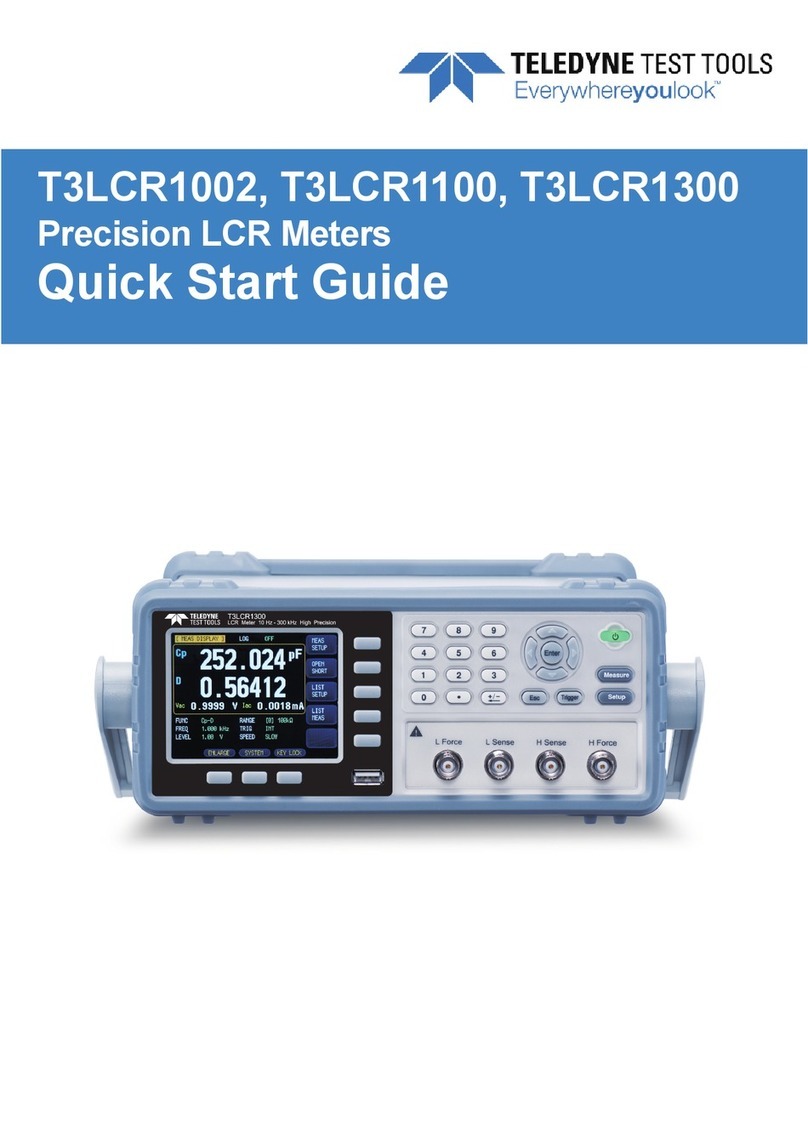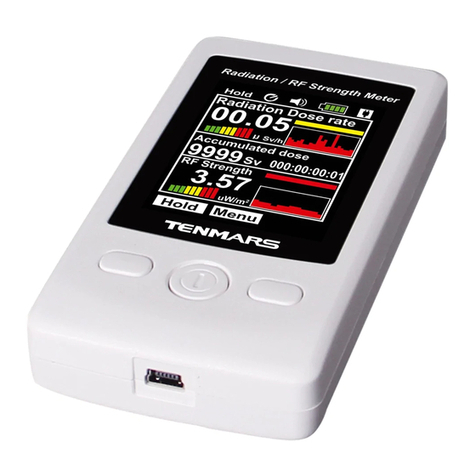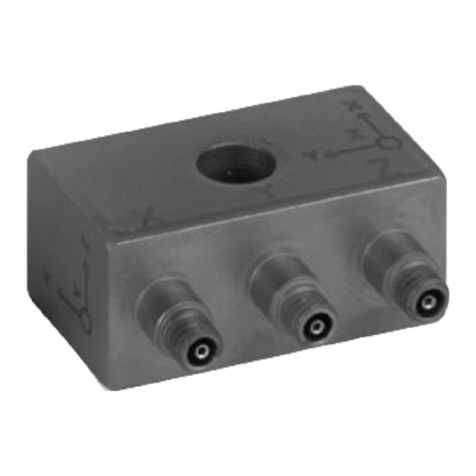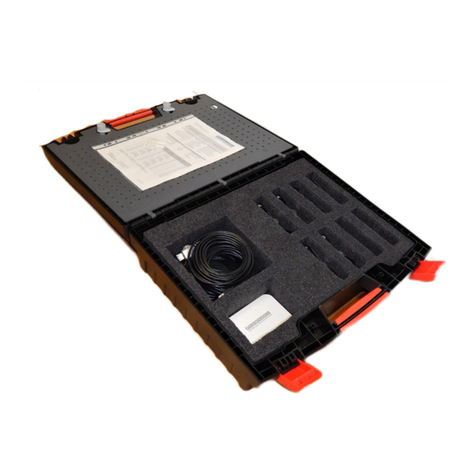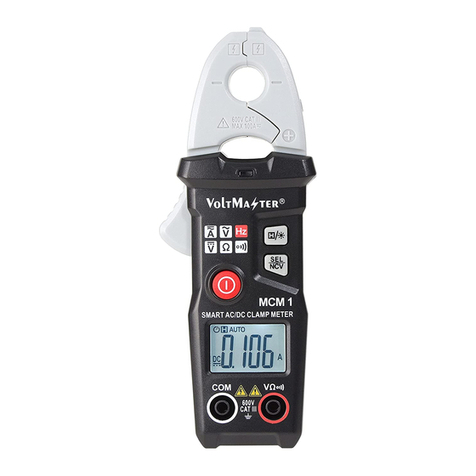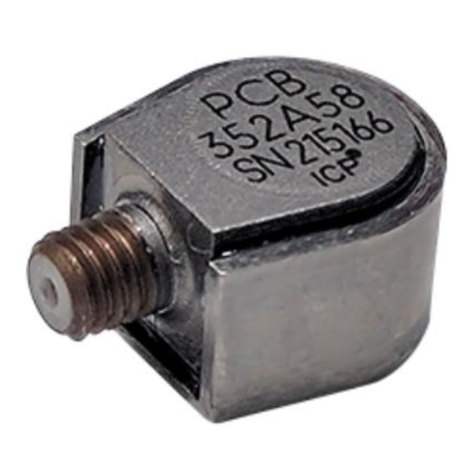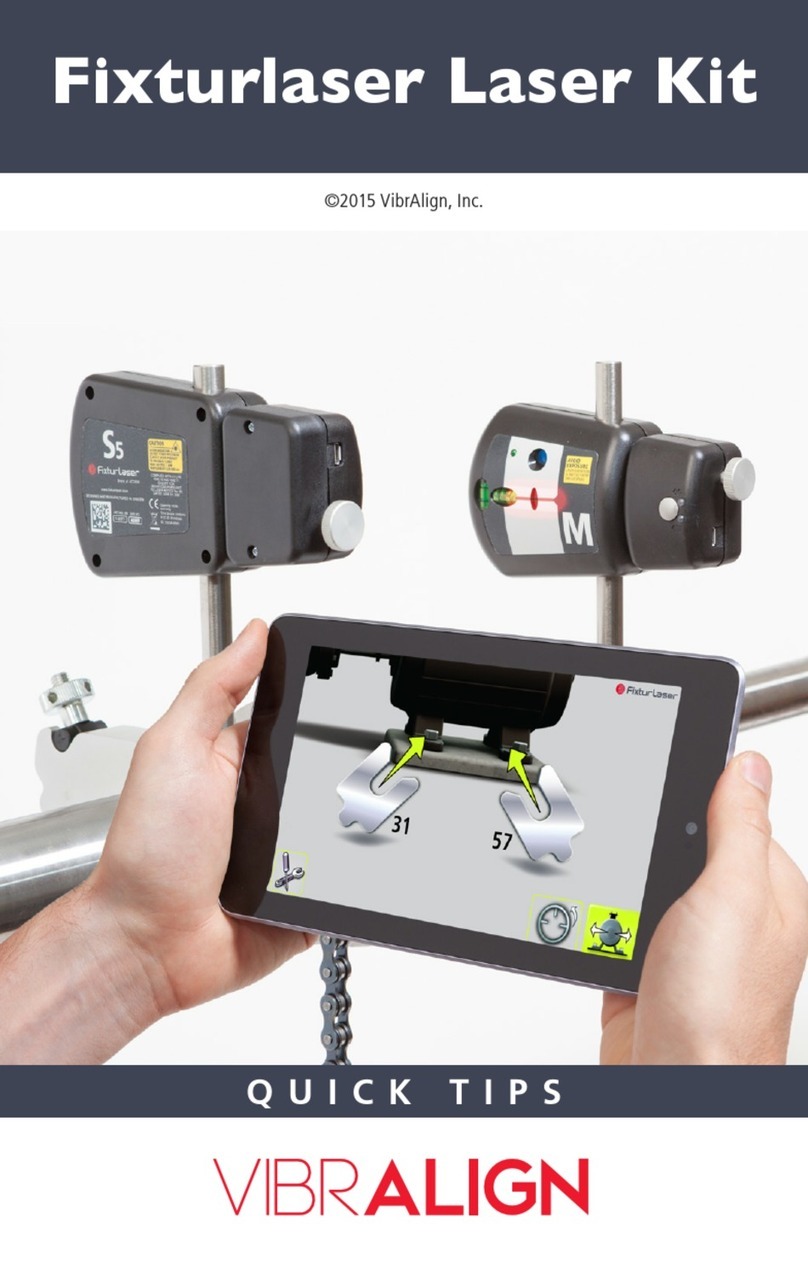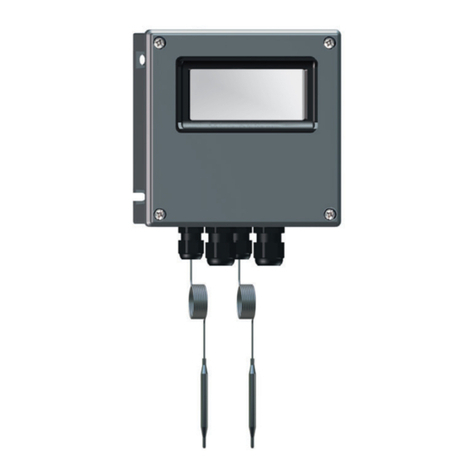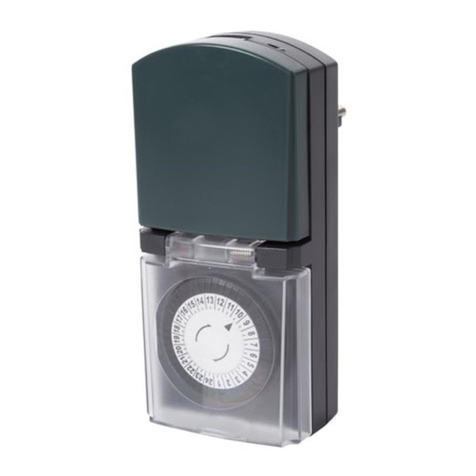Advanced 3D3 User manual

The Advanced®Osmometer
Model 3D3
User’s Guide
3D35 Rev12 042508

Copyright
This user’s guide is copyrighted by Advanced Instruments, Inc. with all
rights reserved. Under copyright laws, this guide may not be reproduced
in any form, in whole or part, without the prior written consent of
Advanced Instruments.
© 2003 Advanced Instruments, Inc.
Advanced Instruments has reviewed this guide thoroughly. All material
contained within is believed reliable, but the accuracy and completeness
are not guaranteed or warranted, and are not intended to be representa-
tions or warranties concerning the product described.
Windows®is a registered trademark of Microsoft orporation in the
United States and other countries. All other trademarks are the property
of Advanced Instruments, Inc.
Hot- ine®Service
If you have any questions or problems regarding the proper operation of
your instrument, please contact our Hot-Line Service department by
calling one of the following numbers.
•800-225-4034 (toll-free within the USA and anada)
•+US 781-320-9000 (elsewhere)
•781-320-0811 (fax)
ii
The Advanced®Model 3D3 User’s Guide

Table of Contents
Safe Use vii
Parts & Accessories xi
Calibrators & Standards xiii
Foreword: Theory and Technique xv
Principles of Freezing-Point Osmometry xv
Instrumentation xvi
Freezing-Point Thermodynamics xvii
Definitions xviii
Figure 1: Standard Freezing Curve xvii
Chapter 1 — Installation & Setup 1
A. Things to do in advance 1
B. Storage of supplies 2
. Installation 2
D. Power-up 6
Figure 2: Model 3D3 Osmometer and Acccessories 3
Figure 3: Back Panel 5
able 1: Model 3D3 Osmometer Packing List 3
Chapter 2 — Instrument Operation 11
Hazardous material cautions 11
A. Function of major components 11
B. Fluid check and startup 18
. Setup 19
D. Test 28
iii

The Advanced®Model 3D3 User’s Guide
E. Sample preparation 28
F. Sample tubes and sample sizes 28
G. Sample test procedure 29
Repeatability tips 33
Figure 4: Model 3D3 Components and Controls 12
able 2: Communications Port Connections 14
able 3: Printer Power Connections 15
able 4: Printer Port Connections 16
able 5: Setup Menu Options 20
able 6: est Mode Options 28
Chapter 3 — Standards & Quality Control 35
A. Purpose of quality control 35
B. Repeatability and accuracy 35
. Standards and controls 36
D. Maintenance of standards 36
E. Quality control implementation 37
Chapter 4 — Calibration 39
Chapter 5 — Troubleshooting & Service 43
A. Service & maintenance cautions 43
B. Obtaining service 44
. Routine maintenance 45
D. Shutdown and storage 46
E. Troubleshooting 46
F. Test 48
G. Adjustment and replacement of parts and assemblies 55
Figure 5: Operating Head 57
Figure 6: Mandrel, Probe and Stir/Freeze Wire Adjustment 61
iv

Appendices 67
Appendix A — Troubleshooting table 67
Appendix B — Product specifications 79
Appendix — Regulatory notices 81
Appendix D — Warranty and warranty duties 83
Appendix E — Supplemental RS-232 information 87
Appendix F — Symbol definitions 89
Appendix G — Service log 93
Figure 7: RS-232 External Cable 88
Index 95
v
Table of Contents

vi
The Advanced®Model 3D3 User’s Guide
Notes:

Safe Use
To reduce the risk of bodily injury, electric shock, fire, and
damage to your instrument, please read and observe the precau-
tions in this User’s Guide.
• If the product is used in a manner not in accordance with the
equipment design, operating instructions or manufacturer's
recommendations, the operation of the product may be
impaired to the extent that a safety hazard is created.
• Do not attempt to perform electrical work if you are not
fully qualified. This manual is not a substitute for electrical
training.
Symbol conventions
The exclamation point within an equilateral triangle is
intended to alert the user to the presence of important oper-
ating and maintenance (servicing) instructions in the litera-
ture accompanying this product.
The lightning flash with arrowhead symbol within an equi-
lateral triangle is intended to alert the user to the presence of
uninsulated dangerous voltage within the product's enclosure
that may be of sufficient magnitude to constitute risk of
electric shock to persons.
The static symbol within an equilateral triangle is intended
to alert the user to the presence of internal components that
could be damaged by static electricity.
This static symbol is intended to alert the user to the pres-
ence of a specific component that could be damaged by stat-
ic electricity.
vii

viii
The Advanced®Model 3D3 User’s Guide
This symbol indicates the presence of alternating current (A ).
This symbol indicates the presence of a fuse.
This symbol indicates the presence of protective earth ground.
General cautions
• This product should be operated only with the type of power source
indicated on the product’s electrical ratings label. Refer to the instal-
lation instructions included with the product.
• If the power cord provided is replaced for any reason or if an alter-
nate cord is used, the cord must be approved for use in the local
country. The power cord must be approved for the product’s listed
operating voltage and be rated at least 20% greater than the ampere
ratings marked on the product’s electrical ratings label. The cord
end that connects to the product must have an IE 60320 connector.
• Plug the product into an approved grounded electrical outlet.
• Do not disable the power cord’s grounding plug.
• If an extension cord or power strip is used, make sure that the cord
or strip is rated for the product, and that the total ampere ratings of
all products plugged into the extension cord or strip do not exceed
80% of the cord’s or strip’s rating limit.
• Route power cords so that they will not be walked on, tripped on, or
pinched by items placed upon or against them. Pay particular atten-
tion to the plug, electrical outlet, and the point where the cord exits
the product.
• Do not pull on cords and cables. When unplugging cords or cables,
grasp the corresponding connector.

ix
Safe Use
• Do not install or use this product in any area subject to extreme
short-term temperature variations, or locations that exceed the speci-
fied operating environment temperatures.
• Never use this product in a wet area.
• To avoid injury or fire hazard, do not operate this product in an
explosive atmosphere.
• Do not install or use the product on an unstable, non-level work sur-
face.
• Do not operate this product with the covers removed or unsecured.

x
The Advanced®Model 3D3 User’s Guide
Notes:

Parts & Accessories
xi
o order parts and accessories, contact the Advanced
Instruments Customer Service Department by using one of the
following numbers.
•800-225-4034 (toll-free within the USA and anada)
•+US 781-320-9000 (elsewhere)
•781-320-3669 (fax)
PART DESCRIPTION
1-Amp Time Delay (T) Fuse for 200-250V
2-Amp Time Delay (T) Fuse for 100-130V
lapper
Disposable Air Filters
Disposable Sample Tubes, 0.2 or 0.25 mL
Thermal Printer with Interface able, Operation Manual,
Thermal Paper Roll, and Printer Power Supply (100-120
VA )
Thermal Printer with Interface able, Operation Manual,
Thermal Paper Roll, and Printer Power Supply (230 VA )
Heat Transfer Fluid
Heat Transfer Fluid Filter
Mandrel
Operator/Supervisor Keys
Power ord (specify voltage and country)
Printer Paper (5 rolls)
PART NO.
7011
7022
3 2241
3D2340
3LA825
3D3555_NA
3D3555_EU
3DA811
4S0710
3LH500
3D3185
3D3835

xii
PART DESCRIPTION
Probe/Stir Wire Alignment Tool
Replacement Sample Probe with Mandrel and three 10-mL
ampules of Probe Bin Setting Fluid (Stainless Steel)
Sample Tube Rack
Serial Port Interface omputer able omputer
onnector, 3 Meters
Serial Port Interface omputer able omputer
onnector, 6 Meters
Serial Port Interface omputer able omputer
onnector, 9 Meters
Service Manual, 3D3/4D3
Stir/Freeze oil
Stir/Freeze Wires
User’s Guide
Yoke
PART NO.
3LA700
3D3700
3LA846
3M3053
3M3056
3M3059
4D35SM
3D2404
3LH243
3D35
3LH230
The Advanced®Model 3D3 User’s Guide

xiii
Calibrators & Standards
o order calibrators and standards, contact the Advanced
Instruments Customer Service Department by using one of the
following numbers.
•800-225-4034 (toll-free within the USA and anada)
•+US 781-320-9000 (elsewhere)
•781-320-3669 (fax)
DESCRIPTION
linitrolTM mOsm/kg Reference Solution (10 5mL ampules)
Five-Level Osmolality Linearity Set: 100, 500, 900, 1500
and 2000 mOsm (10 5mL ampules, 2 of each value)
Protinol®3-Level Protein ontrol Kit (9 3mL bottles, 3 of
each level)
Renol™ Urine Osmolality ontrols (2 levels)
100 mOsm/kg alibration Standard (110mL bottle)
100 mOsm/kg alibration Standard (10 5mL ampules)
500 mOsm/kg alibration Standard (110mL bottle)
500 mOsm/kg alibration Standard (10 5mL ampules)
900 mOsm/kg alibration Standard (110mL bottle)
900 mOsm/kg alibration Standard (10 5mL ampules)
1500 mOsm/kg alibration Standard (110mL bottle)
1500 mOsm/kg alibration Standard (10 5mL ampules)
2000 mOsm/kg alibration Standard (10 5mL ampules)
3000 mOsm/kg alibration Standard (10 5mL ampules)
PART NO.
3LA029
3LA028
3MA028
3LA085
3LA010
3LA011
3LA050
3LA051
3LA090
3LA091
3LA150
3LA151
3LA201
3LA301

xiv
The Advanced®Model 3D3 User’s Guide
Notes:

Foreword
xv
Principles of Freezing-Point Osmometry
When a solute is dissolved in a pure solvent, the following
changes in the solution's properties occur:
•the freezing point is depressed,
•boiling point is raised,
•osmotic pressure is increased, and
•vapor pressure is lowered.
These are the so-called "colligative" or concentrative properties
of the solution which, within reasonable limits, change in direct
proportion to the solute concentration; in other words, the num-
ber of particles in solution.
Of the colligative properties, measurement of the freezing point
allows the concentration of an aqueous solution to be easily
determined with great precision.
The freezing point of pure H2O is precisely +0.010° . One
mole of a non-dissociating solute such as glucose (where the
solute does not dissociate into ionic species, but remains intact),
when dissolved in 1 kilogram (kg) of water will depress the
freezing point by 1.858° . This change is known as the freez-
ing point depression constant for water. The freezing point
depression also depends upon the degree of dissociation of the

xvi
The Advanced®Model 3D3 User’s Guide
solute. If the solute is ionic, the freezing point is depressed by 1.858°
for each ionic species. For example, if one mole of sodium chloride
were to completely dissociate into two ionic species (Na+ and l-) in 1
kg of water, the freezing point would be depressed by 3.716° .
However, dissociation is never complete. Interference between solute
molecules reduces dissociation by a factor called the osmotic coeffi-
cient.
In a simple solution such as glucose or sodium chloride in water, the
freezing point can be measured and the unit concentration easily deter-
mined from an equation or a reference table. However, the equation is
unique for each solute. In a more complex solution, all ionized and
non-dissociated species contribute to the freezing-point depression and
the concentration of each solute cannot be easily determined.
Each of the colligative properties has a similar problem, and though
each of the colligative properties changes in direct proportion to the
solute concentration, each requires a different mode & unit of measure-
ment. Osmolality is a common unit of concentration measurement that
can be used to relate all the colligative properties to each other, and to
other concentration units. Because of its universality, most osmometry
applications regularly use osmolality, expressed as "mOsm/kg H2O", as
the common unit of concentration rather than applying further conver-
sion factors.
Instrumentation
Advanced Osmometers are devices for the determination of the concen-
tration of solutions by means of freezing-point measurement.
Advanced Osmometers utilize high-precision thermometers to sense the
sample temperature, to control the degree of supercooling and freeze
induction, and to measure the freezing point of the sample. They can
routinely determine differences of ±1 mOsm/kg H2O.

xvii
Foreword
Freezing-Point Thermodynamics
The quickest and most precise way to measure the freezing point of a
solution is to supercool it several degrees below its freezing point. It is
unstable in this state, and a mechanical agitation induces crystallization.
The heat of fusion suddenly liberated causes the sample temperature to
rise toward a plateau temperature, where a liquid/solid equilibrium
occurs. The equilibrium temperature is, by definition, the freezing point
of the solution. Managing the plateau temperature for precise measure-
ment is the basis for several patents issued to Augustus Fiske.
The time over which liquid/solid equilibrium develops and is main-
tained, is a function of the speed with which the heat-of-fusion is liber-
ated vs. the speed it is transferred away, or absorbed, by the surrounding
environment. This ratio can be slowed and the equilibrium time
stretched, to give a distinct plateau height measurable to 0.001° .
Sensitive thermistor probes monitor the sample temperature and control
the thermoelectric cooling element. Microprocessor control and auto-
mated operation minimize imprecision due to operator technique.
Figure 1 illustrates the temperature of a sample as it progresses through
the freezing cycle and shows the action of the instrument at each stage
of the cycle.
Figure 1: Standard Freezing Curve

Definitions
Solution: A homogeneous mixture of solute and solvent in which the
solvent is usually the major component, and the solute is the minor
component.
Concentration: The ratio of solute to a given amount of solvent
(molal), or ratio of solute to solution (molar).
The amount of solute is usually expressed in terms of moles (i.e., gram
molecular weights). One mole = 6.028 x 1023molecules (Avogadro's
number). One mole of glucose (180.2 g) and one mole of sodium chlo-
ride (58.4 g) each contain Avogadro's number of molecules.
ommon units of concentration are:
•Molality: Moles of solute per kilogram of pure solvent.
•Osmolality: Osmols of solute particles per kilogram of pure sol-
vent. As noted above, most ionic solutes do not completely dis-
sociate. Osmolality is a unit of concentration that takes into
account the dissociative effect. Osmolality is usually expressed
in mOsm/kg H2O. One milliosmol (mOsm) is 10-3 osmols.
Osmolality is defined as:
where:
ø= osmotic coefficient, which accounts for the degree of mole-
cular dissociation.
n= number of particles into which a molecule can dissociate.
C= molal concentration of the solution.
•Molarity: Moles of solute per liter of solution.
•Osmolarity: Osmols of solute particles per liter of solution.
xviii
The Advanced®Model 3D3 User’s Guide

xix
Foreword
Although molarity and osmolarity may be common units of
measurement in other branches of chemistry, they are not used in
osmometry because the ratio of solute to solution is not linear.
Molality and osmolality are linear, independent of the effect of
temperature and volume displaced by solute. A calculated con-
version between units of molality and molarity is complex and
generally unnecessary when the terms are properly understood.
Freezing Point/Melting Point: The temperature at which the liquid
and solid phases of a substance will remain together in equilibrium.
Freezing-Point Depression: When a solute is added to a solvent, the
freezing point of the solvent is lowered. In aqueous solutions, one
mOsm of solute per kilogram of water depresses the freezing point by
1.858 millidegrees elsius (m° ).
Supercooling: The tendency of a substance to remain in the liquid
state when cooled below its freezing point.
Crystallization Temperature: Aqueous solutions can be induced to
freeze (i.e., crystallize) most reliably when supercooled. When super-
cooled, agitating the solution (freeze pulse) induces crystal formation.
The crystallization temperature is the temperature at which crystalliza-
tion is induced. During crystallization, the heat of fusion raises the
temperature of the sample to an ice/water freezing-point plateau.
Heat of Fusion: The heat released when the mobile molecules of a liq-
uid are frozen into rigid ice crystals.
Freezing-Point Plateau: The constant temperature maintained during
the time that ice and liquid exist in isothermal equilibrium after crystal-
lization occurs.

xx
The Advanced®Model 3D3 User’s Guide
Notes:
Table of contents
Other Advanced Measuring Instrument manuals
Popular Measuring Instrument manuals by other brands
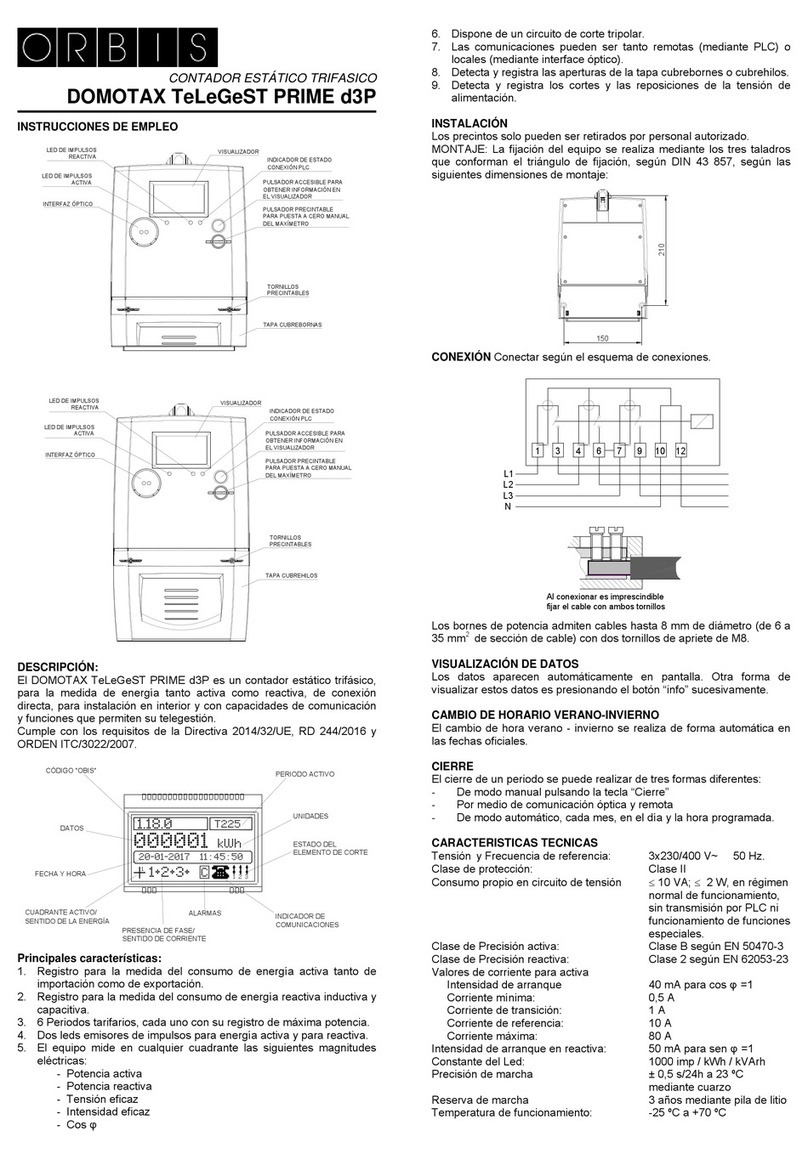
Orbis
Orbis DOMOTAX TeLeGeST PRIME d3P INSTRUCTIONS ON USE

Motorline professional
Motorline professional MFE user manual
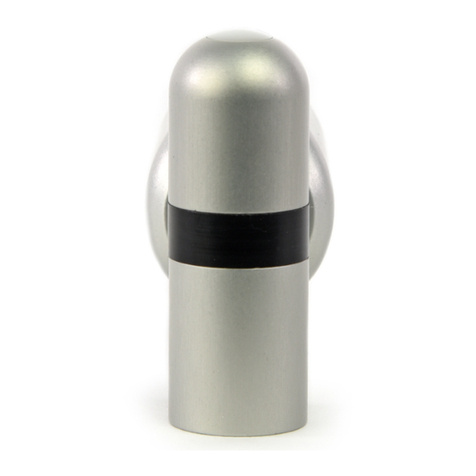
Apogee Instruments
Apogee Instruments SP-722-SS Operator's manual
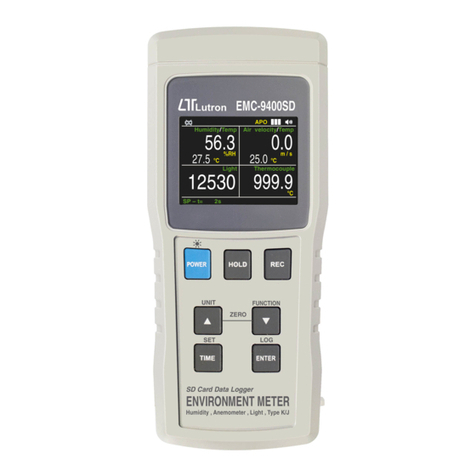
Lutron Electronics
Lutron Electronics EMC-9400SD Operation manual

Endress+Hauser
Endress+Hauser Liquiphant M operating instructions

Vega
Vega INFO-1 operating manual
